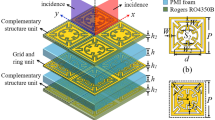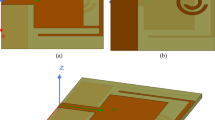Abstract
Here, a simple frequency selective surface (FSS) is intuitively designed, and two such FSS are placed at right angle with each other, with a small predetermined air gap between them, to form a composite FSS structure, and a conical dielectric ring resonator (DRR) loaded monopole antenna is placed in between the two FSS. The DRR loaded monopole offers wide impedance bandwidth from 6 to 20 GHz, with a peak gain of 4 dBi. This composite FSS causes rejection of frequency band of nearly 2 GHz from anywhere in between 6 and 20 GHz, the wavelength of the center frequency of the rejected band being proportional to the dimension of the FSS and distance of the composite FSS from the antenna. Hence the composite FSS shows bandstop character, whereas it also causes 6–7 dB gain enhancement in its passband. The FSS structure is non complex, cost effective, and easy to fabricate.
Access provided by CONRICYT-eBooks. Download conference paper PDF
Similar content being viewed by others
1 Introduction
Frequency selective surfaces (FSSs) are planer periodic metallic structures etched on dielectric substrate, and it has found its various applications in the performance modification and enhancement of different antennas. FSS can be used to control the transmission and/or reflection of an incident electromagnetic (EM) wave and hence shows bandpass or bandstop characteristics [1]. Recently, FSSs with multiple independent transmission bands are required for various applications, and hence several approaches are explored by the researchers to present multi-band transmissions such as use of multiple layers [2], concentric square loops [3], anchor shaped geometries [4], lumped element resonators [5], and so on. On the other hand, dielectric resonator antenna (DRA) has attracted significant attention due to its various advantageous properties, and different shapes of dielectric ring resonator loaded monopole antenna has been already studied [6,7,8].
Here, two simple FSS are kept at right angle with each other, to form a composite FSS, and a small air gap is introduced between the two FSS. An ultra wide band (UWB) conical shaped dielectric ring resonator (DRR) loaded monopole antenna is placed at a predetermined distance from the composite FSS. It is observed that the FSS behaves like a bandstop filter, the wavelength of its stop band being directly proportional to its dimension, and distance from the antenna. On the other hand, it enhances the gain by nearly 6 dB in its passband. The bandstop characteristic of the composite FSS is verified through parametric study. The most interesting part of the work is the use of FSS along with UWB DRR loaded monopole, which is proposed here for the first time, as far our knowledge.
2 Antenna Configuration
The dimension and the top view of the small conical piece of dielectric resonator, that has been used to design the DRR is shown in Fig. 1a, b, where H = 6 mm, and rU = 2.5 mm and rL = 7.5 mm. Figure 1c shows the cross sectional view of the conical DRR loaded monopole antenna, where a = 2 mm and p = 11 mm.
The dimension of the FSS is proportional to the wavelength of the rejected frequency band. The geometry of the proposed FSS is shown in Fig. 1d, where it is observed that the FSS has square cross section with a simple metallic mesh designed on a Arlon (ε = 2.7) substrate. ‘L’ indicates the length of the FSS, and ‘d’ and ‘s’, which characterize an unit cell of the FSS, are kept 5 and 1 mm respectively. Here, the FSS for a particular frequency 10 GHz, for which L = 30 mm, is shown in the figure.
The top view of the proposed configuration is given in Fig. 1e, where it is seen that two similar FSS are kept at right angle to each other, with a small gap ‘g’ = 1 mm between them at one corner of the ground plane. The distance between the antenna and each of the FSS is kept L/2. The rejected frequency band is a function of L. The diagram is given for L = 30 mm. Two FSS, kept at right angle to each other with a small predetermined gap of 1 mm between them, forms a composite FSS structure.
3 Simulation Results for Optimum Design Parameters
Initially in Fig. 2, the return loss characteristics of the only UWB DRR loaded monopole is shown. Then in Fig. 3 the S11 parameter of proposed configuration is studied for different values of L, and the observation is presented in a tabular form below in Table 1.
Hence, it is evident that the composite FSS shows bandstop behaviour, where the dimension ‘L’ is equal to the wavelength of the center frequency of the rejected frequency band.
Taking L = 30 mm, the radiation pattern in the X-Z plane of the proposed configuration and the standalone UWB antenna is compared at 6 and 16.3 GHz, and shown in Figs. 4 and 5. It is clearly seen that the peak gain of the UWB antenna is nearly 3.5 dBi at both 6 GHz and 16.3 GHz, whereas, after using the composite FSS, the radiation pattern become directive due to reflection from the composite FSS and the peak gain increases to 8 dBi at 6 GHz and 11 dBi at 16.3 GHz at nearly −55°. Thus the use of the composite FSS causes nearly 5–7 dB gain enhancement.
4 Conclusion
It is evident that the proposed composite FSS, though quite simple in structure, but successful to eliminate any frequency band of 2 GHz from 6 to 20 GHz which is covered by this DRR loaded monopole, depending on the dimension of the FSS and distance of the composite FSS from the antenna, along with significant gain enhancement in its passband. But, there are various parameters that control the performance modification of the antenna which need detailed study and analysis. All the theoretical details will be revealed in near future and fabrication and experiment will be done to validate this concept. Moreover, the role of the gap in between the two FSS is to be investigated with greater attention.
References
Wu, T. K., [Frequency Selective Surface and Grid Array], Wiley, New York, USA, (1997).
Salehi, M., and Behdad, N., “A second-order dual X-/Ka-band frequency selective surface,” IEEE Microwave and Wireless Components Letters 18, 785–788 (2008).
Wu, T. K., “Four-band frequency selective surface with double square loop patch elements,” IEEE Transactions on Antennas and Propagation 42, 1659–1663, (1994).
Yan, M., Qu, S., Wang, J., Zhang, J., Zhou, H., Chen, H., and Zheng, L., “A miniaturized dual-band FSS with stable resonacne frequencies of 2.4 GHz/5 GHz for WLAN applications,” IEEE Antennas and Wireless Propagation Letters 13, 895–898 (2014).
Xu, R. R., Zhao, H. C., Zong, Z. Y., and Wu, W., “Dual-band capacitive loaded frequency selective surfaces with close band spacing,” IEEE Microwave and Wireless Components Letters 18, 782–784 (2008).
Guha, D., Gupta, B., and Antar, Y. M., “Hybrid monopole-DRAs using hemispherical/conical-shaped dielectric ring resonators: Improve ultra wideband designs,” IEEE Transactions on Antennas and Propagation 60(1), 393–398, (2012).
Guha, D., Gupta, B., and Antar, Y. M., “New pawn-shaped dielectric ring resonator loaded hybrid monopole antenna for improved ultra-wide bandwidth,” IEEE Antennas and Wireless Propagation Letters 8, 1178–1181 (2009).
Ozzaim, C., “Monopole antenna loaded by a stepped radius dielectric ring resonator for ultrawide bandwidth,” IEEE Antennas and Wireless Propagation Letters 10, 843–845 (2011).
Acknowledgements
Authors like to thank IIEST, Shibpur and UGC, Govt. of India, for providing financial support.
Author information
Authors and Affiliations
Corresponding author
Editor information
Editors and Affiliations
Rights and permissions
Copyright information
© 2017 Springer Nature Singapore Pte Ltd.
About this paper
Cite this paper
Banerjee, R., Rana, B., Parui, S.K. (2017). Performance Modifications of a Dielectric Ring Resonator Loaded Monopole Using a Composite Frequency Selective Surface. In: Bhattacharya, I., Chakrabarti, S., Reehal, H., Lakshminarayanan, V. (eds) Advances in Optical Science and Engineering. Springer Proceedings in Physics, vol 194. Springer, Singapore. https://doi.org/10.1007/978-981-10-3908-9_57
Download citation
DOI: https://doi.org/10.1007/978-981-10-3908-9_57
Published:
Publisher Name: Springer, Singapore
Print ISBN: 978-981-10-3907-2
Online ISBN: 978-981-10-3908-9
eBook Packages: Physics and AstronomyPhysics and Astronomy (R0)









